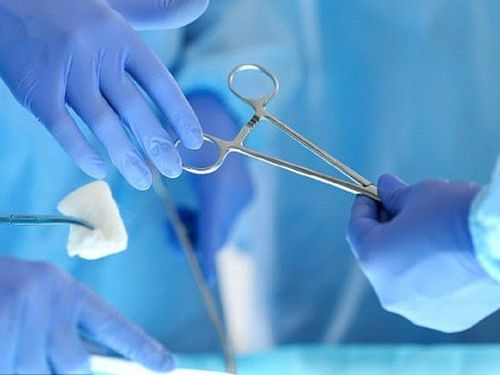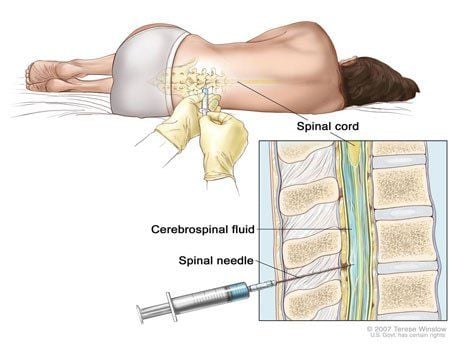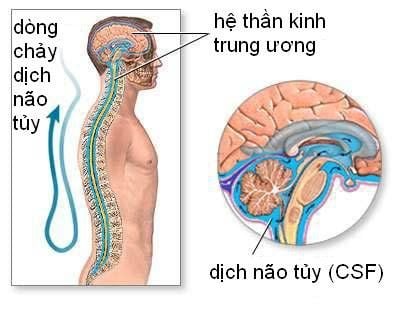This is an automatically translated article.
The article is professionally consulted with Master, Doctor Phan Ngoc Hai - Department of Pediatrics - Neonatology - Vinmec International General Hospital Da Nang. Dr. Hai used to work at the Neonatology Department of Da Nang Obstetrics and Gynecology Hospital and Hoan My Da Nang Hospital. His strength is in general pediatric examination and treatment, neonatal examination and treatment, pediatric resuscitation.Chiari malformation is a birth defect that is divided into 4 types according to the severity of the disease. Type II chiari malformation is called arnold chiari malformation, and it is one of the most common types.
1. What is a chiari malformation?
Chiari malformation is a birth defect, the German professor of pathology Hans Chiari in the 1890s according to the severity of the disease, divided the disease into 4 types as type I, II, III, IV In which the term “Chiari malformation” usually refers to type I, “arnold chiari malformation” refers to type II. Types I and II are also the most common, types III and IV account for a very small percentage.Chiari malformation is rare, the prevalence is less than 1/1000 of the population. Most patients have no symptoms, the disease is discovered incidentally when performing imaging techniques when treating other diseases.
Chiari malformation is described as follows:
The cerebellum has a normal position in the posterior fossa, consisting of two hemispheres, between the two hemispheres there is a small part called the cerebellar pupa. On the anterior surface of the two cerebellar hemispheres are the cerebellar amygdala.
The fourth ventricle contains cerebrospinal fluid located in front of the cerebellum and behind the brain stem. All of these structures are located above the foramen magnum, the largest opening in the base of the skull, where the spinal cord joins the brain stem.
In type I chiari malformation, the cerebellar amygdala moves more than 4mm below the occipital foramen into the cervical canal. This movement can block the flow of cerebrospinal fluid between the spinal canal and the intracranial space. This is a malformation that occurs during fetal development. Chiari malformations may be associated with spinal emptying. Chiari malformation type II occurs mainly in patients with myelomeningocele, which is a birth defect in which the spine and spinal cord do not close properly during fetal development. will be born with a portion of the spinal cord that is open in the back. Characteristic of arnold chiari malformation is downward migration of the medulla oblongata, cerebellum, and fourth ventricle into the cervical canal as well as extension of the pons and fourth ventricle. Type III chiari malformations include birth defects of the spine with partial herniation of the cerebellum (or/and brain) at the back of the head or neck. Chiari malformation type IV: The cerebellum is abnormally developed. This is the rarest and most serious type. Wall chiari malformations are associated with spinal hollow or hydrocephalus. These are abnormalities that occur when cerebrospinal fluid forms a cavity or cyst in the spinal cord. As the fluid compartment expands, it can damage the spinal nerves and cause a variety of symptoms depending on the size and location of the cavity. Symptoms of a chiari malformation may include symptoms of spinal cord voiding or spinal fluid retention.
2. Chiari malformation in children is dangerous?

Severe headache, neck pain. Occipital headache, which is aggravated by sneezing, coughing, or straining. Loss of pain sensation, loss of temperature sensation in the arm or the entire upper extremity. Hands and arms are paralyzed. Stiff paralysis. Dizziness, loss of balance. Double vision, blurred vision, hypersensitivity to light. 2.2 Chiari type II Common symptoms of arnold chiari malformation include: change in breathing rate, possibly short-term apnea, vomiting, involuntary downward eye movements, arm weakness.
2.3 Chiari malformation type III This is a rare but very serious congenital malformation, the child often has a high rate of early death, if the child survives, it will also have severe neurological complications, the disease is often accompanied by hydrocephalus hydrocephalus and other serious birth defects.
2.4 Chiari malformation type IV Children often have symptoms such as headache, scoliosis, loss of sensation, muscle weakness, muscle stiffness, loss of bladder and bowel control; impaired mobility, chronic pain. Most babies with this deformity do not survive past childhood.
3. How is chiari malformation diagnosed?
To diagnose a chiari malformation, determine the type of malformation as well as the degree of spinal hollow, the following techniques can be used:Computed tomography (CT) Magnetic resonance imaging (MRI) Potentiometric method brainstem auditory cue (BAER) Somatosensory evoked potential (SSEP) Myleogram
4. How is chiari malformation treated?

Patients with type II chiari malformation are treated with surgery if symptoms are present and the physician determines that the patient does not have hydrocephalus. Some children with type II chiari malformation have symptoms that develop very rapidly and are critical and require prompt intervention.
The goal of Chiari malformation surgery is to optimally decompress nerve tissue and restore CSF flow to a normal state. Class I chiari decompression surgery involves resection of the posterior aspect of the occipital foramen, posterior portion of the first few cervical vertebrae at the level of the cerebellar amygdala, to help provide more space for the brain and spinal cord. , cerebellum. The cleft was patched with a graft so as not to impede the flow of cerebrospinal fluid.
The hydrocephalus can be drained with a catheter to transfer fluid from the inside of the spinal cord to the outside. Class II chiari malformation decompression surgery is usually limited to decompressing the tissues in the spinal canal and preserving the posterior part of the skull. Possible complications after surgery are cerebrospinal fluid leak, wound infection, postoperative hematoma, blood vessel damage, brain stem damage, pseudomenigocele formation,...
Patients with chiari malformations If before surgery there is only pain, few neurological symptoms, after surgery usually recover well, the symptoms are greatly reduced. For cases of severe nerve damage, muscle weakness, and severe muscle atrophy before surgery, the results after surgery are often less favorable.
As a key area of Vinmec Health system, Pediatrics Department always brings satisfaction to customers and is highly appreciated by industry experts with:
Gathering a team of top doctors and nurses in Pediatrics : consists of leading experts with high professional qualifications (professors, associate professors, doctorates, masters), experienced, worked at major hospitals such as Bach Mai, 108.. Doctors All doctors are well-trained, professional, conscientious, knowledgeable about young psychology. Besides domestic pediatricians, the Department of Pediatrics also has the participation of foreign experts (Japan, Singapore, Australia, USA) who are always pioneers in applying the latest and most effective treatment regimens. . Comprehensive services: In the field of Pediatrics, Vinmec provides a series of continuous medical examination and treatment services from Newborn to Pediatric and Vaccine,... according to international standards to help parents take care of their baby's health from birth to childhood. from birth to adulthood Specialized techniques: Vinmec has successfully deployed many specialized techniques to make the treatment of difficult diseases in Pediatrics more effective: neurosurgery - skull surgery, stem cell transplantation. blood in cancer treatment. Professional care: In addition to understanding children's psychology, Vinmec also pays special attention to the children's play space, helping them to have fun and get used to the hospital's environment, cooperate in treatment, improve the efficiency of medical treatment.
Please dial HOTLINE for more information or register for an appointment HERE. Download MyVinmec app to make appointments faster and to manage your bookings easily.














